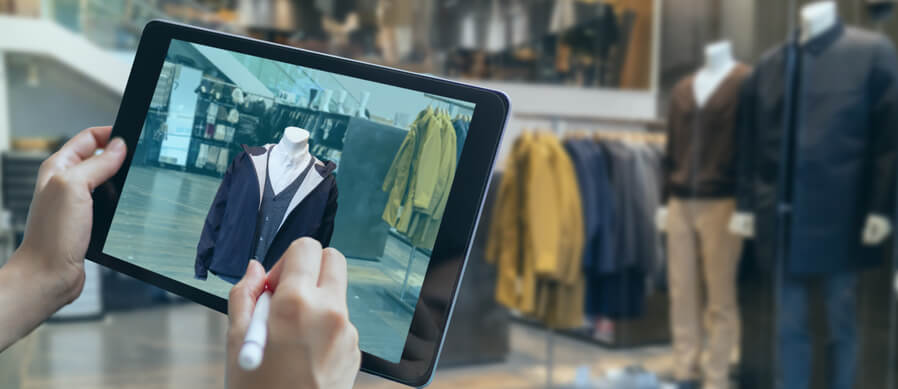How Technology Innovation Will Impact the Future of Fashion
by Roberto Mangual | September 26, 2019

From designing new clothing lines to delivering new customer experiences, fashion thrives on innovation. In today’s digital retail environment, fashion innovation will be driven by advanced technologies, including Augmented Reality, 3D Prototyping, Modeling and Printing, and Artificial Intelligence with Machine Learning.
Augmented Reality
According to research by CPC Strategy, 57% of Millennials and 63% of Gen Z already purchase apparel online from Amazon. Fashion brands and retailers will need to work together to enhance digital shopping, including ways to help customers better visualize and personalize their clothing.
Augmented reality grabbed the spotlight when Pokémon Go exploded onto the gaming scene in 2016. It’s already being used in manufacturing and logistics. While virtual reality (VR) requires a headset and other technology to create a fantasy experience, augmented reality (AR) takes your existing real-world environment and overlays objects and animations onto it.
AR has at least two potential uses in the fashion industry. First, it can be used in the design environment to help designers immerse themselves more fully in their creative process. Designers can grab different garments and use AR to change the fabric, color, embellishments, trims, and even the shape and lines of the clothing to try out different concepts.
The second useful application of AR is for customer experience. As a consumer shops for a sweater, they can select different colors or fabrics and see the changes appear in the photo of the model. Spinning the view around 360 degrees, they can see what the garment looks like from every angle. In an advanced AR experience, consumers may upload their own photos to see how clothing looks on them using their mobile phones.
3D Technologies
One of the most exciting areas of advanced innovation in fashion today is three dimensional technologies. From the manufacturing process to the retail experience, 3D technology makes fashion leap off the flat page or screen and take form. There are many ways 3D technology will impact fashion, and two promising areas are 3D Fit and 3D Printed Fashion.
3D Fit
What can be more disappointing than eagerly awaiting new clothing only to discover that it looked much better in the online photos than it does on your real-life body? 3D fit gives consumers the ability to map their body style—with an easy-to-use mobile app—and accurately envision how they would look wearing any garment without physically trying it on. This technology greatly enhances the digital shopping experience and could lead to greater customer satisfaction and brand loyalty.
3D Printed Fashion
Three dimensional printers have been working their way into fashion businesses for a number of years, and soon, they’ll become more common in consumer homes. For designers, the cost of 3D visualization and prototyping is falling as 3D printers become more widely adopted. According to a recent article in Forbes, “high-end SLA desktop 3D printers can be had for under $5,000. This democratization of the technology will empower smaller designers and unleash a wave of creativity in both design and business models.”
Today, the average consumer 3D printer costs around $700. Perhaps in the not-so-distant future, fashion brands may simply sell designs online, with consumers using 3D fit to size the design and augmented reality to choose options, before printing the garment at home. Not only would consumers benefit from perfectly fitted clothing, the fashion industry would take a giant leap forward in sustainability by reducing textile waste.
Artificial Intelligence and Machine Learning
It can be difficult to wrap our human mind around the power and potential of artificial intelligence. Simply put, AI is the simulation of human intelligence by computer. In machine learning, the system’s programming, combined with a stream of real-time data, enables it to improve and self-correct, based on its own experiences and without additional human input.
AI is capable of taking a tremendous amount of data and outputting recommendations and suggestions that drive business outcomes. Fashion manufacturing can benefit, for example, by using AI to harness big data and predict what lines should be rebalanced. Using historical data, AI can optimize the production cycle, taking into account real-time variables, such as weather, time of day, individual performance of employees working on the line, the products being manufactured, the raw materials being used, and much more.
High Tech Fashion Fuels the Customer Experience
Advanced technologies such as 3D, AR and AI have the potential to reshape the future of the fashion and accessories industry. Fashion brands will need to partner with technology providers with deep understanding of the industry’s needs who have the vision to harness the potential of technological innovation for real-world applications that improve manufacturing, supply chain, retail, and customer experience.
Exenta is a forward looking company. We work with our customers to figure out where advanced technologies intersect with competitive market needs and consumer desires. We offer the only end to end, integrated workflow solution for the fashion industry, and we incorporate practical applications of advanced technologies to ensure our customers stay ahead of the market.


